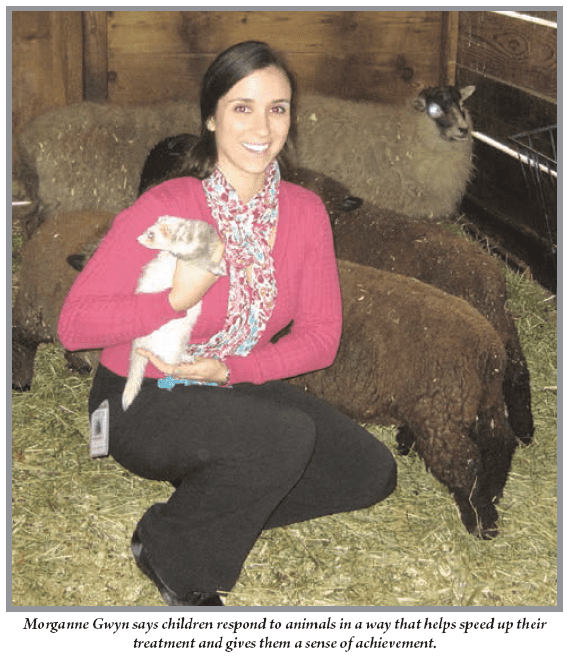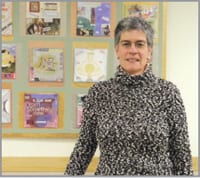Pet Project – Animal-therapy Programs Open Children’s Eyes — and Minds
Katie Calendrillo, a speech-language pathologist at Weldon Rehabilitation Hospital on the Mercy Medical Center Campus, remembers her struggles with a 6-year-old patient a few years ago — he would cry through entire sessions — but she has more memories of the remarkable progress he made after being introduced to horseback riding.
“The only way I could get him to stop crying, or even nod his head, was to call him ‘Bob,’ and that wasn’t even his name … but he thought it was sort of funny,” said Calendrillo, noting that the child had a stuttering problem and was lacking many social skills. His thenoccupational therapist (OT) said that any results would probably be hit or miss. It was with an eye toward accelerating their rate of progress that those at Weldon agreed to place him, with only three other children, in the Children’s Outpatient Therapy Services Therapeutic Riding Program, which takes place at the Wooden Horse Farm in Palmer.
But the results far exceeded expectations.
“Children love animals; it really opens them up to ask questions about them.”
“He was OK to get on the horse, rarely saying a word, and it took him about two weeks to start to independently ask questions about the horse, what they were going to do that day with the horse, and then what could they do the following week,” said Calendrillo, noting that, as the weeks progressed, an amazing transformation happened. “By the end of the program, he couldn’t stop talking about the horse; he had so many questions and was talking with his peers, with some hesitation, but still having a conversation.”
It may seem like a small victory, but there are many stories like this one that offer testimony to the success of using animals in alternative forms of therapy for children with disabilities ranging from social and language problems to motor-skills issues to physical injuries. Known as Animal Assisted Therapy (AAT), the program incorporates animals into therapeutic teaching and learning programs, which may seem very simplistic, but helps to improve human physical, social, emotional, and cognitive functioning.
AAT is one of two alternative-therapy programs, both involving animals, offered as external programs through Weldon Rehabilitation Center for children with social, mental, or physical problems. The Therapeutic Riding Program at the Palmer location is for four patients at a time, due to the amount
of horses available. The other program, which Weldon operates on site at Springfield’s Forest Park Zoo, can take from as few as three to more than a dozen children, depending on their social or physical issues. Children get to see, touch, hold (when appropriate), and learn about a wide variety of animals, including turtles, rabbits, snakes, and sheep, as well as larger animals like bears, cougars, and camels.
“We can all do our job perfectly fine without the zoo, or without hippo therapy, but it definitely adds something to our program. When you have a kid where you’ve tried everything and they’re at a plateau and not making any gains, you need something different to get them to the next mountain.”
Both programs are offered once a week for an hour, for six to eight weeks; the riding program is conducted twice a year, and the program at the zoo occurs two to three times a year. The children are grouped by age, from preschool (ages 3 to 5) to older children (6 to 10 years of age). In what’s called the Zoo Keeper program, the older kids, if they are physically able, are allowed to actually clean stalls and cages, feed and tend to the animals, and really help out at the farm or the zoo.
For this issue’s focus on alternative health, HCN talked with two speech-language therapists and an OT at Weldon to learn more about both highly successful programs, and how using a different modality, even one that is rough or furry, smooth or scaly, large or small, can positively — and in some cases very quickly, by therapists’ standards — facilitate the process of helping a child live a more fulfilling and healthy life.
Change of Venue
“Children love animals; it really opens them up to ask questions about them,” Calendrillo told HCN, hitting on the essence of the two initiatives.
“And how often do you get to pet a parakeet, or a baby turkey, or peacock, or baby pigs?” she asked rhetorically. “It’s just a new experience and a great setting for them.”
And with children that are affected by issues that involve interaction with other humans, sometimes dealing with an alternative — say a soft, fluffy bunny somewhere other than a hospital setting is often just what the doctor ordered. Peer interactions while with the animals, said Morganne Gwyn, another speech-language pathologist at Weldon, is another goal for children with various disabilities.
“We see different kids outside of our therapy sessions [in Weldon],” she explained, “and while we work one on one with kids here, we get to see them interact with their peers at the zoo.” But when the therapists and OT get down to work, petting and holding an animal are just the mechanics of a greater goal.
“There’s also always a lot going on, so we can work on attention,” Carolyn Moore, a Weldon OT, explained.
“There may be another group there, or a peacock is walking in the background, so it’s a great place to work on attention issues because you have to tell them, ‘stay focused; I know there’s a lot going on, but try to focus here.’”
The focus at the zoo is a dry run for situations they’ll soon face in kindergarten, she went on. “If they’re in a class of 22 children, and Joey is shaking his leg, and Sally is spinning around in the corner, to get that kind of focus prework is important.”
And this is especially important for this age group that doesn’t go to preschool yet, or have that early classroom experience,” added Gwyn. “A lot of times, this is the very first time that they’ve been outside without their parents nearby.”
Moore and Gwyn told HCN that sometimes, especially with language issues, a child is very smart, but without the ability to communicate without feeling that everyone is looking at them. Thus, their-self esteem plummets, and they shut down, similar to the young boy who was stuttering, and — through the workwith horses at the Wooden Horse Farm —was soon having conversations with those his own age, a milestone for a child with a language disability.
“It’s the turn-taking that they lack, and as Morganne said, if they don’t have that school-based setting, it’s hard to turn-take and share and make eye contact in their life,” said Moore.
“We look as a group at all of our kids, and sometimes we have a physical therapist or a speech therapist attend the program, based on what the kids’ needs are,” added Gwyn. That’s what Calendrillo called ‘matching’ kids with those who have similar disabilities as their peers.
Those with autism may be in a group with children affected by Down syndrome for work on speech and language delays, while another group with gross-motor-skill and sensory delays will be grouped together, she noted. Over the years, the staff has been to both locations with children affected with muscular dystrophy, cerebral palsy, brain-trauma injuries, and any issue that affects a child’s healthy quality of life.
Dog and Pony Show
The three Weldon therapists who spoke with HCN said they did not have to acquire special training with animals for these programs, and use the two forms of treatment in conjunction with other strategies they deploy.
“Especially in occupational therapy,” said Moore, “you try and pull out what is going to be motivating to a child; animals are motivating, and going to the zoo is a childhood activity.” The other animal-therapy activity, Weldon’s Therapeutic Riding Program at the farm, includes another modality called hippotherapy. According to the American Hippotherapy Assoc. (AHA), the term is derived from the Greek hippos (horse), and hippotherapy literally refers to treatment aided by a horse. Moore explaine to HCN the difference between therapeutic riding and hippotherapy, both of which fall under the umbrella of equine-assisted therapy.
Hippotherapy is a physical, occupational, or speech-and-language therapy treatment strategy that specifically utilizes equine movement as the child rides. “For a child who has gait problems or walking problems, a horse’s pelvis is identical to a human pelvis; it’s just flipped 90 degrees,” explained Moore. “So when you put a child on the horse’s back and the horse starts to walk, they feel that gait … that’s what they are supposed to feel, and if they do it long enough, it becomes part of their motor memory.”
“When you put a child on the horse’s back and the horse starts to walk, they feel that gait … that’s what they are supposed to feel, and if they do it long enough, it becomes part of their motor memory.”
Varieties of equine-assisted therapy may have the patient on or off the horse, and sometimes it’s more about the experience of being around the horse, touching, feeling, sitting, and the like, said Moore. “We teeter between both treatments, by using the horse as our modality and giving the child the movement input that we need versus us using the horse to play and move around.”
The ‘a-ha’ moment, Moore said, is when the child realizes what that sensation of flow when walking is supposed to feel like. She said there are few better ways to replicate that feeling than riding on a horse that is walking properly.
“We’ve also had great input with stuttering children through the therapeutic riding, like working on breath support, posture, and breathing sequences that they learn to maintain,” Calendrillo explained, adding that they have seen kids, who just didn’t want to communicate and shied away from everyone, want to get on the horse. “The horse just brings it out of them.”
So much so, in fact, that some kids have stopped their stuttering altogether.
“It’s that work on breath support in sync; they’ve trained themselves to breathe that certain way, and they haven’t had stuttering issues since,” said Calendrillo. “It was just that alternative avenue.”
Not to downplay the therapeutic room at Weldon — it’s a colorful and bright space full of padded mats for physical therapy, platform swings, and ladders for movement — but there’s just something about animals, no matter what their size, shape or feel, that speaks to children, Gwyn said.
Mane Event
All those who spoke with HCN agree that seeing the look on a small patient’s face when they realize they’ve just accomplished something, no matter how simple, is what makes their occupations so special. And therapy programs involving animals simply provide new avenues for realizing such rewards.
“We can all do our job perfectly fine without the zoo, or without hippotherapy, but it definitely adds something to our program,” said Moore. “When you have a kid where you’ve tried everything and they’re at a plateau and not making any gains, you need something different to get them to the next mountain.”
The therapeutic programs with animals outside the walls of Weldon can be a kind of ‘reset button’ for some children who have done every activity the staff can think of, “so they get that motivation and come back prepared to do new things,” she continued.
Whether at Weldon, the farm, or the zoo, a therapist has many tools to assist children and target individual goals for a variety of human ailments. Adding animals into the mix is just another programming mechanism in their portfolio of options that can make a huge difference in a child’s life, one small victory at a time.



